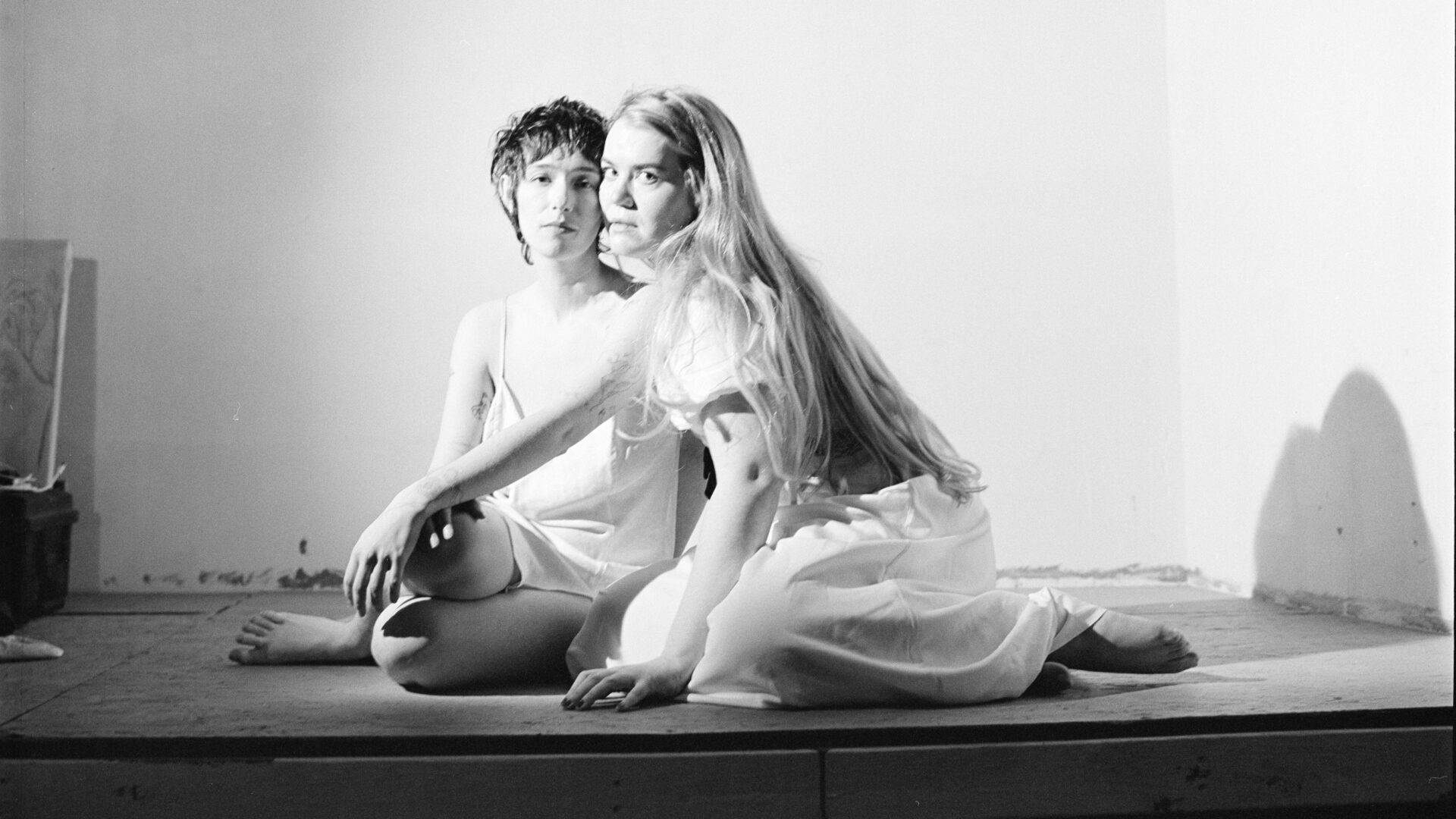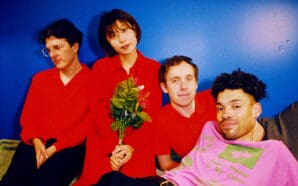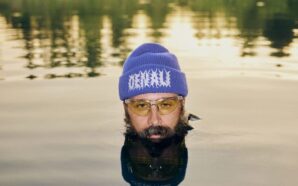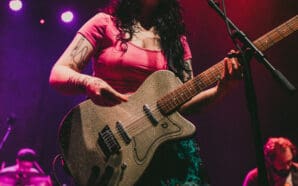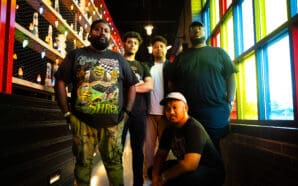The last time Brooklyn indie pop duo (and phriends of PHILTHY) Daisy the Great were in the City of Brotherly Love and Sisterly Affection was March of last year, when they were opening The Fillmore’s 2,500-capacity main room for The Kooks and The Vaccines (Their recent history has also seen them opening Union Transfer for half•alive and providing support for The Happy Fits at Theatre of Living Arts… so it’s not like mega-rooms were new to them…) However, on September 13th – three dates into their North American headlining tour – Daisy the Great will be at 140-capacity metal bar Kung Fu Necktie (which is literally about across the street, and yet seemingly in an entirely different galaxy), the most intimate local space Kelley Dugan and Mina Walker have played since self-booking themselves a gig at Ortlieb’s on their 2019 DIY debut tour.
Their upcoming monthlong tour, which kicks off 9/10 in Boston, is in support of Daisy the Great’s third full-length, The Rubber Teeth Talk, which was produced by Catherine Marks (known for her work with PHILTHY phriends and phavorites boygenius, Lowertown, and Wolf Alice) and dropped this June via longtime home S-Curve Records. I recently got a chance to catch up with Kelley and Mina via Zoom, who tell me about creating the worlds and dream worlds of The Rubber Teeth Talk, working with the guy who discovered The Jonas Brothers, and getting the opportunity to return to a few particularly intimate spaces (KFN is significantly smaller than most venues on this run.) that are a little more rich with life and character than some of the other venues in Fishtown…
*Interview has been edited for length and clarity.
Izzy Cihak: Your third full-length, The Rubber Teeth Talk, dropped this summer. How do you feel like the album compares to All You Need is Time and I’m Not Getting Any Taller? In every chat we’ve had, you’ve mentioned never having any rules relating to sound or genre when you’re writing. And I know you’ve mentioned dreams serving as a significant influence, or at least the concept of dreams.
Kelley Dugan: It really felt like it was building on the last records, but I think we brought in a little bit more sense of rawness and playful energy and went even further with letting ourselves feel like it’s okay to have those imperfections and let those imperfections and unexpected moments be the special thing in the song.
Mina Walker: Our first record, we had no idea how to make a record [laughs]. We kind of went fully on instinct and impulse. On our second record, we were like, “Okay! Now we’re gonna make a professional-feeling record!” It felt like the first one was all id, and the second one was meticulous, like, “We’re making songs,” and, “This needs to be the right way to make the song!” We still had our playful energy, but I think we were more focused on how to make the songs perfect and fully flushed-out. I think this record is kind of harkening back to the first record and letting go of everything we’ve learned and acting on instinct after you’ve built a language for yourself. It can be playful, but it’s rooted in a lot of practice and a lot of knowledge, and then kind of letting it all go. I think this one is a fun use of play from a more mature place… or something like that [laughs].
Izzy: The record was produced by Catherine Marks, who has worked on a lot of amazing records. How was it working with her? What do you feel like she brought to your sound, or even just the sessions?
Mina: She kind of was the one who allowed us to do the thing I was saying. Working with somebody who is an iconic producer, there’s always a little bit of, “Am I gonna feel like they know more than me? Am I gonna feel like I need to listen to whatever they say, or it’s not gonna be good?” And she had none of that. The biggest thing that she brought to the table was that she allowed us to completely be ourselves and feel confidence in our decisions. She also had amazing ideas that were super aligned with us. We had a conversation with her before choosing her to record the record, and we were talking about ideas, because we had sent her all the demos of the record, and she was just super excited. We were all on the same page about building worlds for every song.
I think she really allowed us to play and gave us confidence to make a lot of decisions on our own, too. Like, on the last record I never played any guitar or bass or anything, even though I wrote a lot of the parts. But she was like, “Mina! Every song needs your guitar playing on it!” just that feeling of, “Oh! I have a style!” She wanted to bring out every band player’s voice in all of the songs, which is what Kelley said, leaning into some of the mistakes and stuff is where style comes from. So, I think she helped us define our style. And I think if you listen to any of her records, all of the records she produced sound completely different. It doesn’t sound like, “Oh, it definitely sounds like Catherine Marks made this.” It just sounds like it’s the best possible way that that band can be.
Izzy: You’ve put out a number of cool music videos for the album, and I know you both went to NYU for acting, so I’m curious what kinds of things have inspired the most recent music videos, or visuals in general?
Kelley: So many things! Right when we’re writing the songs, we start talking about the music videos most of the time. A lot of these videos came from imagining a bigger world around a real-life thing. I’m thinking about the “Dog” music video, that is kind of a blown-up, imaginative version of how I first wrote that song, which is going on a walk in New York in that place. We filmed the music video exactly where it was [laughs]. I was walking, and it was a really bad day, and I walked up to this curb where there was a Winnie-the-Pooh stuffed animal that was face-down in a puddle, looking very sad and forgotten, and I was like, “I am him!” So, I sat there and wrote “Dog.” When we were talking about building the music video, we were like, “Let’s make the biggest, most fun version of that ever,” which is that I see him, but then I become him, and I’m wearing this giant Winnie-the-Pooh suit. So, it was really just following the fun idea, or the important idea or the important visual, and then making that really big.
I think of, also, the “Bird Bones” video. That song is about a friend of ours that passed away, and we used her drawings to project behind us. That’s another instance where that’s something really small that we made the whole world of the video to encompass the feeling and immerse ourselves and whoever’s listening.
Mina: The album is super about dreams and dreamworlds. I think we built a dreamworld around every song. Even the cover of the album is a stone mask of my face and Kelley facing the stone mask of my face. Aesthetically, we really wanted to play with the uncanny valley and stretching out what is human and what is not human, and what feels real and not real, and what you accept in a dream.
Kelley: We built a lot of masks. There’s a lot of mask imagery for the album cover. And for the “Mary’s At The Carnival” [which you may have heard during a block of “summertime jams” on the August edition of Philthy Radio, now streaming] video, we built masks. There were a lot of handmade aspects to the videos and a lot of theatrical elements. In the “Ballerina” video there are prosthetics and big stilts. There’s just a lot of art happening!
Mina: This album is the most that we’ve had creative control over all of the videos. We directed three of them and we creative-directed all of them. We’ve made sure that our aesthetic vision was passing through the whole thing. There’s a lot of lyrical stuff, too, about your face changing. In “Dream Song,” the first lyric is, “Thought I saw my face.” We wanted to create these different worlds. And, with the masks, we painted them ourselves. Our friend, Olive Ryan, made the stone molds of us, and then we sat and painted them. We wanted this one to be super hands-on, we do everything. I feel like it’s the most solid visual world that we’ve created for a body of work.
Kelley: Zach Tavel, who worked on “Ballerina” with us, edited “Ballerina,” but we edited all of the other videos, and I feel like that is also such a huge part of our storytelling and getting our vision across. It’s really lovely to be able to produce the videos fully and let it be what we imagine it to be.
Izzy: You’ve been with S-Curve Records for a while now. How has it been working with them and being part of that whole label family over the years? I have to admit, I don’t know a ton about them other than you.
Kelley: S-Curve has been around for a really long time. It’s headed by Steve Greenberg, and it’s very small and hands-on. I think we really are lucky to be in a situation where we have a lot of conversations with the people that are at our label. It’s something that’s really close and we can talk about everything, and everyone is available when you need them. They also really let us drive; they have a lot of great ideas, but they also really respect their artists’ point of view. As we were just talking about, we do all the videos. We’re always leading everything.
Mina: Something that I like about the label is kind of what you were saying, that it doesn’t feel like there’s an aesthetic to the label. It doesn’t feel like, “This label does this type of music.” I feel like every artist from the label kind of does their own thing, and I don’t feel like I’m being lumped into any genre or any kind of clique of music. We have so many friends within the music world, but I don’t think that we’re very placeable in terms of genre, so I think it’s fun to be on a label where it’s not like, “Oh, that label only does this type of music.” I think that everybody is super individual on the label, and we feel super individual.
Kelley: And Steve always follows the music that he likes. All the music he’s been working with has been really eclectic and spans a lot of different genres and spaces. He does have a history of three brothers. Like, he did The Jonas Brothers initially. And that’s perfect, because we are also three brothers [laughs]. It’s funny, because when I was growing up, I did have a huge Jonas Brothers phase, but I also had a big Joss Stone phase, when I was like seven or something like that, and that was Steve at that time! I was like, “I was following you when I was a little child,” [laughs]. I grew up going to a lot of theatre and different types of music shows, but my first mainstream concert was going to see The Jonas Brothers at Madison Square Garden, and that was Steve’s tour, and he was at the show. That’s crazy…
Izzy: Speaking of touring, you’re gearing up for a headlining tour, but you actually did a spring headlining tour, sort of in-between Spectacle: Daisy the Great vs. Tony Visconti and the full-length, and it was your first full-on headlining run in a little while. How did those dates go?
Mina: That was a fun tour because that was a lot of places that we had never headlined before, so we kind of wanted to visit some cities to see what the vibe was. It was cool to be able to play some of the songs from the album before they were out: “Lemon Seeds,” “Dog,” “Mary’s At The Carnival,” and “Ballerina,” but that was out… It was really fun to play stuff from the album and play a lot of the old album, too. We wanted to play a lot of the songs from the All You Need Is Time record in those places. We also hadn’t toured in a year, so we were like, “Let’s do one more little tour with All You Need Is Time to kind of wrap it up.” We’ll probably still play some of the songs from that on this next tour, but this tour will be focused on The Rubber Teeth Talk. It was a really sweet tour, and it was a fun way to get everyone excited for the new album.
Izzy: What can be expected of the live show – you talked about it a little bit — on the upcoming dates? I think it’s been about two and a half years since we last saw you headlining here in Philly, when you played The Foundry.
Kelley: That’s exciting! We’re gonna have a five-piece band, so it’s the two of us and then three more band members. It’s a pretty live show. I feel like our shows always have a path through them, where some moments are heavier and more energetic, and then we have a lot of intimate moments, as well. There are a lot of vocal harmonies. It’s a very fun album and it’s one that we’re really proud of and super, super excited to play. We’re gonna be playing the whole new album, and more music from our discography, as well. It should be a really, really fun show! I’m really excited!
Izzy: I think your show at Kung Fu Necktie will actually be the most intimate show you’ve played since your very first tour, when you played Ortlieb’s. How do you like playing the extra sweaty, extra cozy barrooms? They’re kinda my favorite, but you’ve said that it is fun to be able to run around on big stages, and you’ve been on a lot of huge stages on a lot of huge tours. How do you like the super sort of punk rock spaces?
Mina: We love it! It’s where we started, there’s so much freedom to it. It’s always the small venues where you have some of the most special shows. I love being able to see everybody and talk to everybody after the show. It always brings me back to when we started making music, and 2019, when we decided to do our first headline tour, or DIY tour. It feels so special to be in an intimate space with people and be able to hear everybody talking to you and stuff.
Kelley: Also, those types of rooms have so much character, the room itself feels like a person that’s there. It feels like a space you’re stepping into that feels really rich with life, and it feels really lucky to be able to play shows in a space like that.
Izzy: Have you been to Kung Fu Necktie before? I don’t think you’ve played there.
Kelley: We have some friends that used to go there growing up, so we’ve heard a lot of good, sweet things.
Mina: I think some of our band members have played there before in other bands.
Izzy: It’s great! It’s definitely mostly a metal and hardcore venue now, but it wasn’t always. I always describe it as looking and feeling like a brothel in a Rob Zombie movie, in the best way. It’s very ‘70s sleaze, velvet paintings…
Mina: I feel like the smaller venues always fit the aesthetic of the band more than the giant ones. You feel like you’re a band in a movie when you get to play intimate venues. And there’s always character. I was reading the Mac DeMarco article where he said he never wanted to play arenas or anything, that there’s just something that doesn’t seem fun or that it fits his music, and I feel like that’s so respectable, the idea that you need to continue to get bigger and bigger and bigger, but then realizing that sometimes getting bigger and bigger and bigger doesn’t always feel the best [laughs]. I feel like the smaller venues, like Kelley said, they’re their own character, they’re their own part of the show. And you feel it when you’re in them.
*Get your tickets here.
